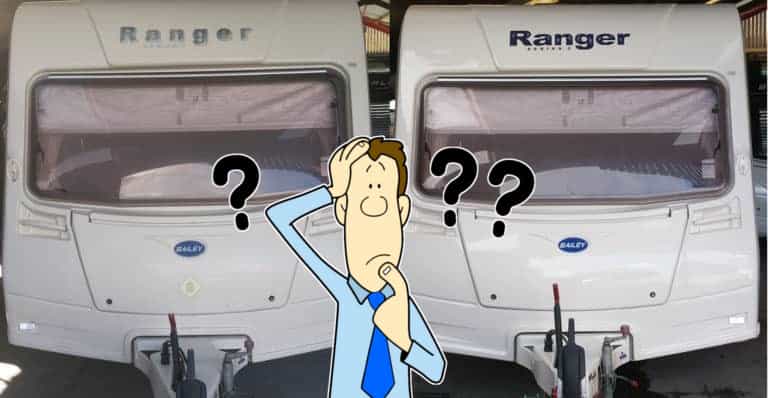
Based on my own experiences of cleaning our caravan and the feedback I receive from our guests, I’ve got quite a few posts now, including how to clean the roof and removing black streaks. However, once all that actual cleaning is done, your caravan may not have the shine you’re truly after.
When it comes to polishing a caravan, its important to recognise the body of your caravan is made up of different materials. You have the flat sides/roof of painted aluminium. However, many caravans (not all) have large fibreglass sections on the front and back.
Fibreglass surfaces are finished in what’s called a gelcoat, and standard car/caravan polish may not be able to restore it. However, using a gelcoat polish on the sides of your caravan could lead to potential damage. Therefore with this post on how to polish a caravan, I’ll discuss which products to use and where on a caravan.

In a couple of my other caravan posts, such as caravan winter storage tips, I discuss using products such as Fenwicks Overwinter Protection or Bobby Dazzler.
These may be viewed by some as polish as they do provide additional surface protection. However, they are really just a glaze, a quick solution (spray-on), as opposed to what this post is going to talk about, proper polishing.
What I mean by proper polishing is good old elbow work. However, overuse of abrasive polishes can damage the caravan.
Therefore, I think products such as Fenwicks Overwinter Protection and Bobby Dazzler do still have their place.
Disclaimer: Hey! By the way… any links on this page that lead to products on Amazon or Caravan Guard are affiliate links, and I earn a commission if you make a purchase, with no additional cost to you 🙂
- Dissolves waste and removes odours naturally and has delightful mild fragrance
Want To Visit Horton Common? – Book Here
Table of Contents
How To Polish Caravan Gelcoat Finished Fibreglass Panels
Many caravans have a front and back panel almost completely made of fibreglass. However, with caravans such as Bailey’s based on the Alu-Tech construction technique, that’s not the case.
Even the front/back of a Bailey Alu-Tech caravan has an aluminium skin with some plastic body panel additions.
Therefore, if you do own a caravan with purely aluminium body panels, please skip this section. It is very important that gelcoat cutting compound polishes are not used on the aluminium body panels of your caravan.
Sure, it might make the surface look good, but you would be effectively removing a thin layer of paint. And the paint on caravans is thin enough as it is.
That’s why in my post on how not to clean a caravan, I state that T-Cut, a common polishing cutting compound used on cars, should not be used on caravan painted panels.
Car body panels are painted/lacquered in a completely different way than thinly painted aluminium caravan body panels.
What Is Gelcoat & Why Does It Need Polishing
I’ve done two DIY fibreglass roof projects now, so I’ve got a bit of experience working with it.
We also have an old fibreglass garage door that needed a bit of TLC, so we applied a new layer of gelcoat to it. Fibreglass caravan body panels are made of glass fibre matt and resin.
The result is a tough, durable panel, the problem though is that the resin used to produce the fibreglass panel is not resistant to UV. Therefore a final layer is added, in the case of caravan body panels, a white gelcoat.
Gelcoat is UV resistant, but it does eventually suffer from UV degradation and oxidisation. In the simplest terms, your caravan fibreglass panels start to feel rough and bumpy.
Now, to make them smooth again, its going to take something with a bit more oomph than standard car polish. The polish used to bring back the shine on caravan fibreglass panels has to be a little bit more abrasive.
The best product currently available for the job on caravans is 3M Perfect-It Gelcoat Light Cutting Wax.
I discuss this product below, but first, the video from Martin ‘The Caravan Nut’ does a good job showing the 3M cutting and wax polish in action.
As you can see from the video above, using the 3M cutting/polishing compound does take quite a bit of elbow grease.
However, it can really improve the surface finish and shine of the fibreglass panels on your caravan.
Now, 3M actually produce a couple of different grades of 3M cutting compound/wax polish, light, medium and heavy. But not all of the grades are suitable for safely polishing your caravan gelcoat surfaces.
Which 3M Perfect-It Gelcoat Cutting Wax Is Suitable For Polishing a Caravan?
In the video, you can see that Martin and his video subscriber Colin are using 3M Perfect-It Gelcoat Medium Cutting Compound & Wax.
There is clearly a picture of a caravan on the bottle, and it specifically references for use on caravans on the label.
However, the current label on the 3M Medium grade cutting wax polish there is now no reference for use on caravans or motorhomes.
This would appear odd (and slightly concerning) at first, as it would appear that 3M no longer support the safe use of their 3M cutting compound wax polish for polishing caravan gelcoat panels.
However, as stated previously, 3M does produce two other grades of the same polish, light and heavy.
As the medium grade no longer states for use on caravans, I thought it would be unlikely the heavy grade would reference caravans, and it doesn’t.
However, the current label for the light grade of 3M cutting compound wax polish does reference for use on caravans.

The light grade of the 3M cutting compound wax polish has been rebranded for use on caravans for ‘slightly contaminated’ surfaces: Image – Amazon.co.uk
Light Or Medium Grade 3M Cutting Compound Wax Polish?
I do not believe that Martin/Colin in the video above caused any damage to the caravan gelcoat using the medium grade, even though 3M appears to have changed their mind on its applicable use. That gelcoat panel was heavily oxidised and weathered.
Furthermore, this was the first time Colin had used a gelcoat polish on his caravan. However, it is important to remember this is an abrasive polish, it is effectively removing a thin layer of the gelcoat.
Typically a gelcoat layer is 0.5 mm to 0.8 mm. Therefore, overuse of an abrasive polish would get through that gelcoat eventually.
Hence, that’s probably why 3M has now branded the light grade instead of the medium grade as a suitable product for polishing a caravan.
Therefore, I would advise going forward only using the light grade and using it sparingly. This is not a polish (even the light grade) you should be using to polish the gelcoat on your caravan frequently.
And I know I’ve said this many times already, but please don’t use this polish on your caravans painted aluminium panels. I’ll now discuss a general caravan polish below.
Caravan Bodywork Polish – Autoglym Super Resin
There are a number of products out there branded as caravan polish. However, a product that has stood out to me in my conversations with our guests is Autoglym Super Resin.
There has been quite a bit of debate online about whether this is actually a polish or just a ‘glaze’.
For instance, the spray-on Fenwicks products for caravans are purely glazing products. For something to be regarded as an actual polish, it has to have some abrasive qualities.
As I’ve now stated several times, with aluminium body panels on a caravan, you have to be very careful with abrasive polishes.
Autoglym Super Resin is still technically a polish that contains abrasives, but its one of if not the lowest abrasive polish available.
The main feature of Autoglym Super Resin is its ability to fill in light scratches etc. Hence the resin aspect of the product.
To improve the surface finish and produce a shine to the body panels. The video below discusses the attributes of Autoglym Super Resin.
Autoglym does state that Super Resin can be used to polish caravans. However, they also state ‘Use only on smooth surfaces. Do not polish dimpled paintwork‘.
Now, dimpled caravan body panels are a thing of the past. Though if you have purchased an older second-hand caravan, this may be applicable to you.
With the dimpled finish, excessive polish/wax can get caught up in the dimples etc, its just generally a very difficult surface to polish.
I would also not use Super Resin, or any caravan polish for that matter, on the acrylic windows. I would also be careful around the caravan stickers.
Getting your polishing cloth caught on the edge of the sticker may start to lift it off the bodywork.
However, in general, I think Autoglym Super Resin is one of if not the best products available to polish caravan bodywork.

Autoglym Super Resin is a product definitely worth considering if you wish to use a polish on your caravans body panels: Image – Amazon.co.uk
Conclusions On How to Polish A Caravan
One of the key points I hoped you picked up on above is the importance of recognising what a polish is actually doing. Its removing the upper rough surface finish to reveal a smooth finish below.
Yes, many of the products, such as those referenced above, include waxes and resins to protect the surface after polishing.
However, the fact remains that surface gelcoat/paint is now thinner than it was before. Hence, you cannot use polishing agents (especially highly abrasive polishes) indefinitely.
Use them sparingly, once, maybe twice a year. And only use the right product for the right type of caravan body panel.
You’ll also want to get hold of some microfibre cloths for applying and removing polish, these things are just the best!
I hope you found this post useful on how to polish a caravan. Much of the above is also applicable to polishing motorhomes as well.
Finally, I hope at some point in the future, you will consider coming to visit us here at Horton Common. We have five fully serviced pitches, all with expansive views over the Staffordshire Moorlands and Peak District National Park. 🙂
Want To Visit Horton Common? – Book Here


